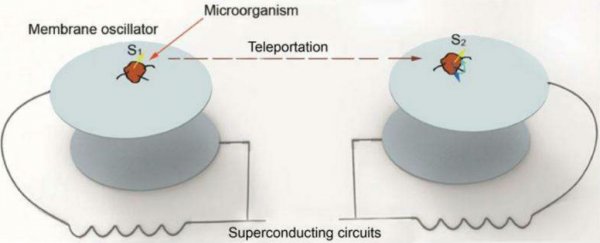While the possibility of teleporting entire objects from one place to another like they do in the movies is way beyond our current - and near-future - capabilities, the same can't be said for the memory of our existence.
For the first time, physicists have proposed a method for teleporting the memory of a living creature to another location, while also offering up a way to create a Schrödinger's cat-like state, where this creature theoretically exists in two places at the same time. At this stage, they've only figured out how to do this to bacteria, but they say mastering it could be the key to teleporting more complex things.
"We propose a straightforward method to put a microorganism in two places at the same time, and provide a scheme to teleport the quantum state of a microorganism," says Tongcang Li from Purdue University. "I hope our unconventional work will inspire more people to think seriously about quantum teleportation of a microorganism and its potential applications in the future."
When we talk about the memory of a living creature, we're not talking about memories about its life. It's the memory of the creature's existence at an atomic level - its internal quantum state.
The work refers to research published by Austrian physicist Erwin Schrödinger back in 1935, in which he famously proposed that a cat could exist in different states known as 'superpositions', in two or more places at once, until it was observed. Basically, the cat could be in both dead and alive states in different places until someone actually observed it.
This idea is at the core of what makes quantum computers so exciting - instead of being limited to the combinations of 0s and 1s that make up the binary codes of our current computers, the qubits used in quantum computers can be in a superposition state of both 0 and 1 and any given moment, expanding the processing capabilities by several orders of magnitude.
Now Li and his colleagues say that if they cooled a common species of bacteria - called mycoplasma - down to a frozen state, you could not only achieve a quantum superposition state like what Schrödinger's cat theoretically ended up in, but you could also allow for its quantum state to be teleported elsewhere.
Basically what you'd have to do is place a living bacterium on top of a device called an electromechanical membrane oscillator, and cool them both down to a cryogenic temperature. A study published earlier this month has shown that, at these temperatures, it's possible to put an oscillator membrane in a superposition state, so they suggest that the same thing would happen to the bacterium sitting on top.
"We propose to simply put a small microbe on top of the aluminum membrane. The microbe will also be in a superposition state when the aluminum membrane is in a superposition state. The principle is quite simple," Li told Ian Sample at The Guardian.
Now that the bacterium has achieved a superposition state, the researchers say the memory of its internal quantum state could be teleported to another living creature using superconducting microwave circuits. They explain their thinking below:
"With a strong magnetic field gradient, the internal states of a microorganism, such as the electron spin of a glycine radical, can be entangled with its centre-of-mass motion and be teleported to a remote microorganism. Since internal states of an organism contain information, this proposal provides a scheme for teleporting information or memories between two remote organisms."
Li told The Guardian that this second part of the experiment is what could actually make it useful - for example, it could be used to detect defects of DNA and proteins in a microbe, or to image the microbe to a single-electron-spin sensitivity.
Now, obviously this is purely theoretical stuff, and even Li himself admits that it's "unconventional", but with physicsts proposing earlier this month that the memory of matter that's been sucked into a black hole can be retrieved thanks to a mechanism that's similar to quantum teleportation, scientists are probably going to be pursuing this train of thought until it no longer makes sense. It's just nice to be along for the ride.
The research has been published in the journal Science Bulletin.
